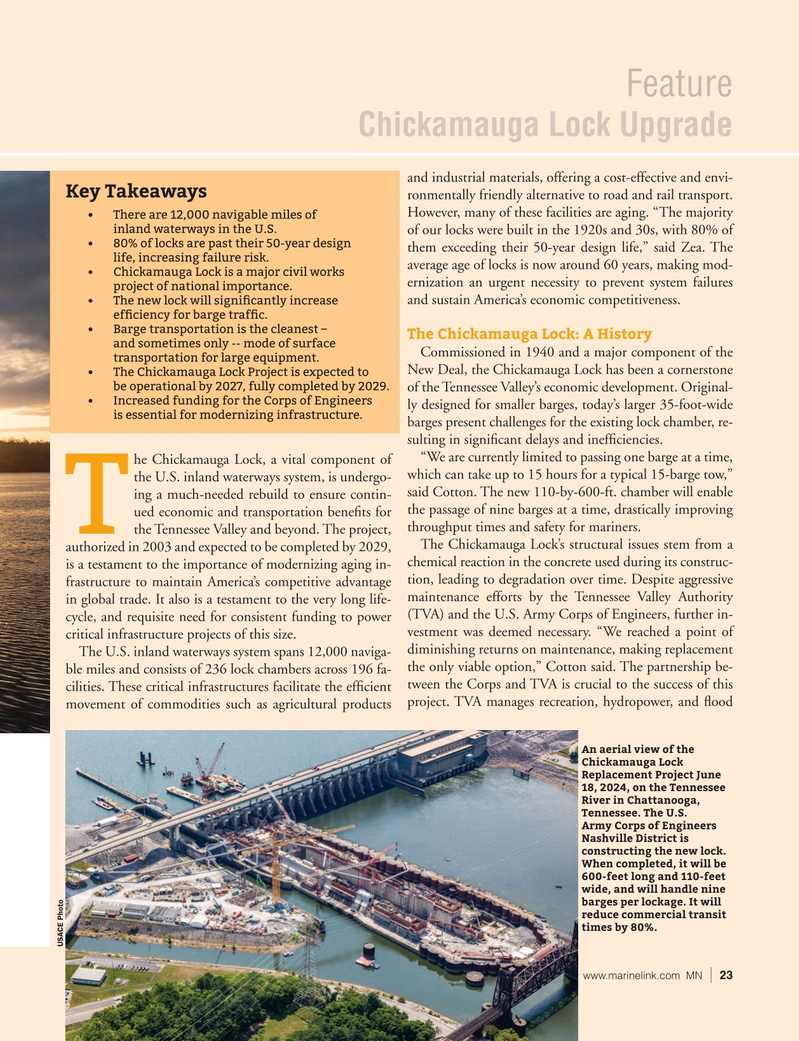
Page 23: of Marine News Magazine (May 2025)
Read this page in Pdf, Flash or Html5 edition of May 2025 Marine News Magazine
Feature
Chickamauga Lock Upgrade and industrial materials, offering a cost-effective and envi-
Key Takeaways ronmentally friendly alternative to road and rail transport.
However, many of these facilities are aging. “The majority • There are 12,000 navigable miles of inland waterways in the U.S.
of our locks were built in the 1920s and 30s, with 80% of • 80% of locks are past their 50-year design them exceeding their 50-year design life,” said Zea. The life, increasing failure risk.
average age of locks is now around 60 years, making mod- • Chickamauga Lock is a major civil works ernization an urgent necessity to prevent system failures project of national importance.
and sustain America’s economic competitiveness.
• The new lock will signi? cantly increase ef? ciency for barge traf? c.
• Barge transportation is the cleanest –
The Chickamauga Lock: A History and sometimes only -- mode of surface
Commissioned in 1940 and a major component of the transportation for large equipment.
New Deal, the Chickamauga Lock has been a cornerstone • The Chickamauga Lock Project is expected to be operational by 2027, fully completed by 2029.
of the Tennessee Valley’s economic development. Original- • Increased funding for the Corps of Engineers ly designed for smaller barges, today’s larger 35-foot-wide is essential for modernizing infrastructure.
barges present challenges for the existing lock chamber, re- sulting in signi? cant delays and inef? ciencies.
“We are currently limited to passing one barge at a time, he Chickamauga Lock, a vital component of which can take up to 15 hours for a typical 15-barge tow,” the U.S. inland waterways system, is undergo- said Cotton. The new 110-by-600-ft. chamber will enable ing a much-needed rebuild to ensure contin- ued economic and transportation bene? ts for the passage of nine barges at a time, drastically improving the Tennessee Valley and beyond. The project, throughput times and safety for mariners.
T
The Chickamauga Lock’s structural issues stem from a authorized in 2003 and expected to be completed by 2029, chemical reaction in the concrete used during its construc- is a testament to the importance of modernizing aging in- frastructure to maintain America’s competitive advantage tion, leading to degradation over time. Despite aggressive maintenance efforts by the Tennessee Valley Authority in global trade. It also is a testament to the very long life- cycle, and requisite need for consistent funding to power (TVA) and the U.S. Army Corps of Engineers, further in- vestment was deemed necessary. “We reached a point of critical infrastructure projects of this size.
diminishing returns on maintenance, making replacement
The U.S. inland waterways system spans 12,000 naviga- the only viable option,” Cotton said. The partnership be- ble miles and consists of 236 lock chambers across 196 fa- cilities. These critical infrastructures facilitate the ef? cient tween the Corps and TVA is crucial to the success of this movement of commodities such as agricultural products project. TVA manages recreation, hydropower, and ? ood
An aerial view of the
Chickamauga Lock
Replacement Project June 18, 2024, on the Tennessee
River in Chattanooga,
Tennessee. The U.S.
Army Corps of Engineers
Nashville District is constructing the new lock.
When completed, it will be 600-feet long and 110-feet wide, and will handle nine barges per lockage. It will reduce commercial transit times by 80%.
USACE Photo www.marinelink.com MN | 23

 22
22

 24
24
